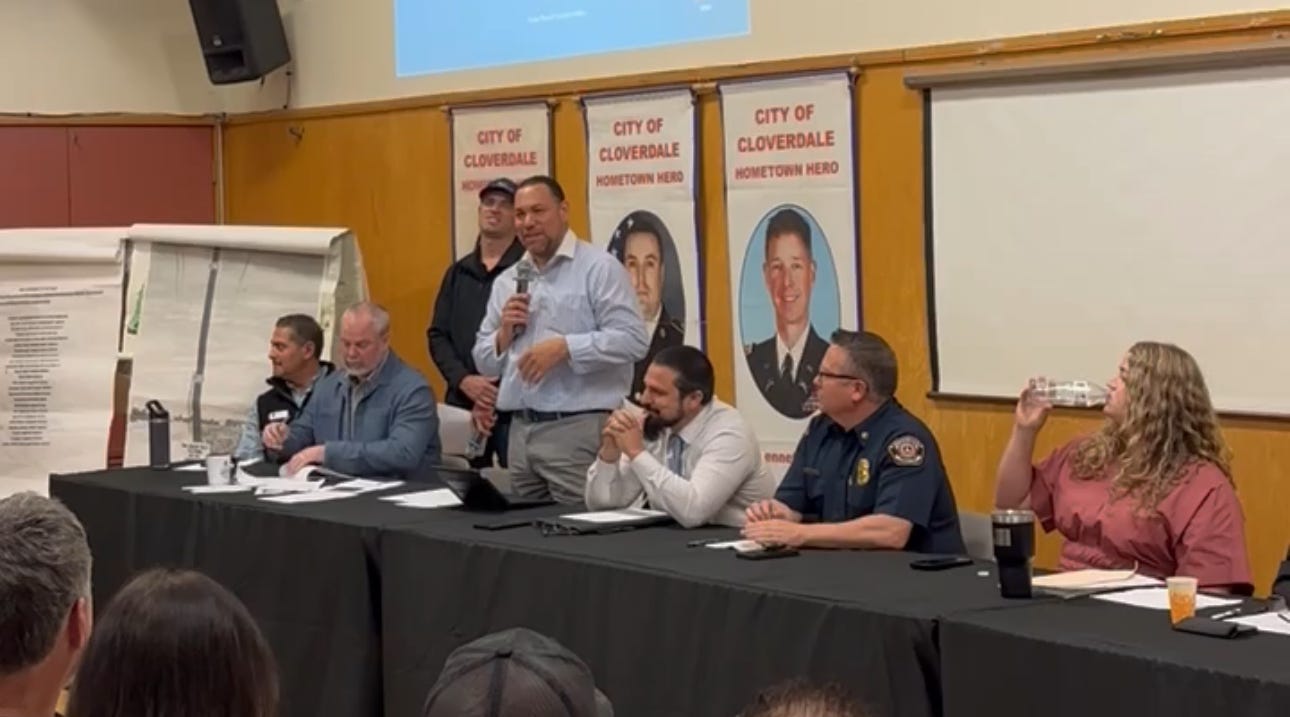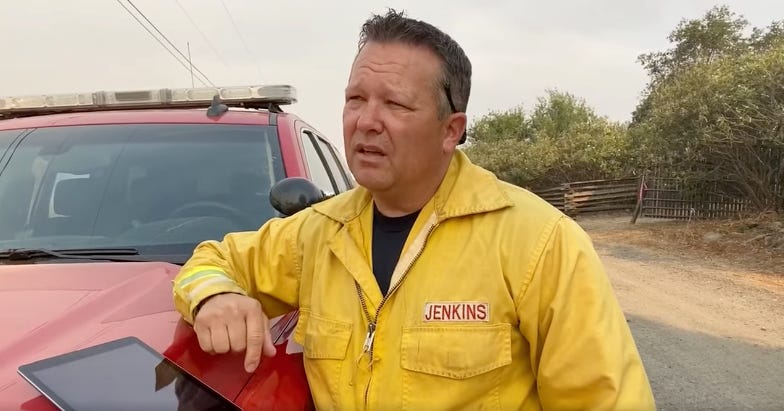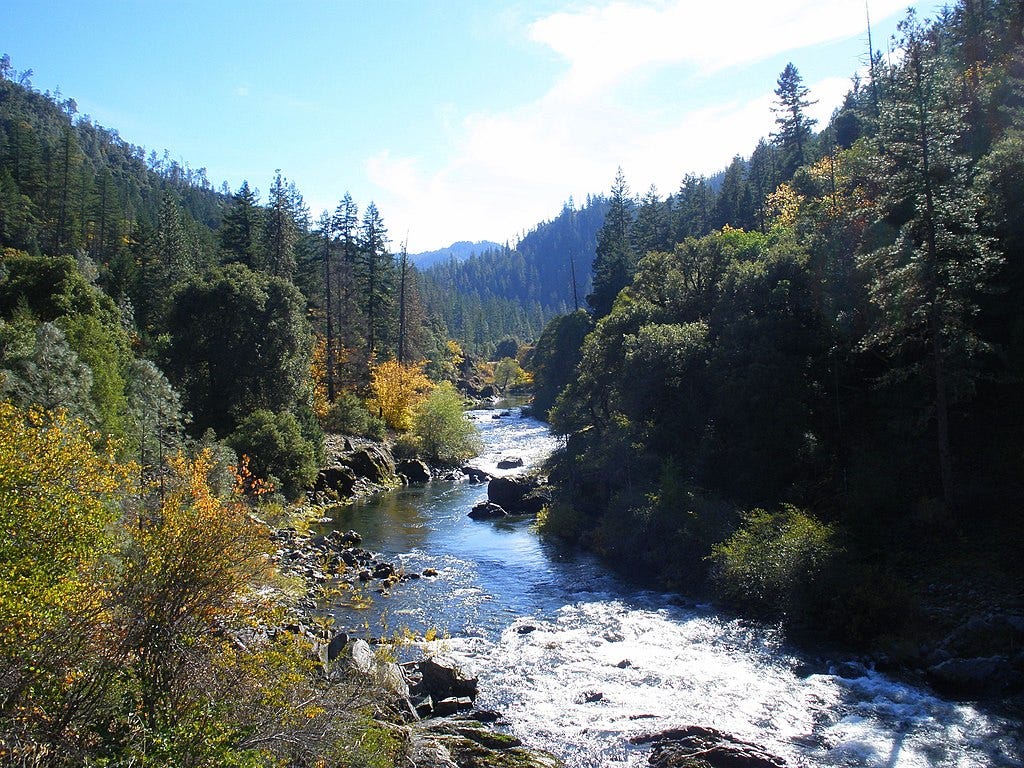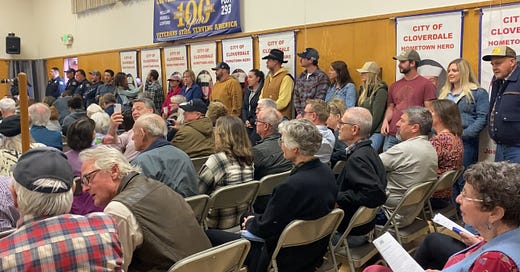At the Cloverdale Town Hall, Rural California Community Takes First Step Against Dam Removals: "It's Not a Done Deal."
Organized by Cloverdale Mayor Todd Lands and grassroots leader Chris Coulombe, Lake, Sonoma, and Mendocino counties gathered to fight for water rights and the future of a threatened region.
Cloverdale Fire Chief Jason Jenkins opened last night’s Town Hall by acknowledging the building was filled well beyond capacity. Community members lined the walls and spilled into the entryway of the Veteran’s Hall to hear from a panel on the Potter Valley Project dam removals.
It was one of the first attempts to rally Lake, Mendocino, and Sonoma counties, whose survival and way of life is threatened by a massive dam removal project insiders say will cut water supply for 600,000 people—along with fire suppression, economic well-being, agriculture, and natural ecosystems.
“This is not a partisan issue; water is necessary for existence,” said Cloverdale Mayor Todd Lands. He urged the community to find a common sense plan, and said the proposed solution—a seasonal water diversion that offers to pull some water during the winter but provide no storage for summer—is not acceptable. “Every single person in this room will be negatively affected by the proposed solution for an Eel River diversion.”
Sonoma County Supervisor James Gore acknowledged that the proposed diversion would leave a number of impacted communities including Lake County high and dry, but said he was still fighting for it.
“I’m gonna honor that this is not a global solution,” Gore admitted, closing out a statement the crowd received in silence.
Chris Coulombe, a Sonoma County resident and grassroots leader in the fight for water, seemed to capture the mood of those gathered.
“At the end of the day, our community is responsible,” Coulombe said. While traveling the North Coast in his 2024 electoral bid against Congressman Jared Huffman—who was not present—Coulombe discovered at least 70% of the community does not realize what is about to happen to their water. “We must get this information out, we must ensure truth has a seat at the table.”
“The one piece of information I need everyone here to walk away knowing tonight—and this is in their studies, commissioned by PG&E—is that if we go forward with this proposal as it stands, we will not have water in Lake Mendocino six years out of 10.”
Lake County and Tribal Voices Silenced
When Lake County Supervisor Bruno Sabatier spoke, he turned to Supervisor Gore. “I appreciate the words from Supervisor Gore and I apologize that I’m going to throw some of it back at you. We are not looking for support to keep Lake Pillsbury, we can fight our own fights. What we want is support to have our voices heard, which has been completely declined.”
In his comments to the crowd, Sabatier said his first priority was to combat the idea that locals have no say in what happens to the dams, and no power to protect their water.
“‘It’s a done deal.’ That’s what we get told at every single meeting that we go to with the state of California, whether it’s the governor’s office, the Water Resources Department, Fish & Wildlife, we are looked at like we are idiots for asking ‘Why is this happening?’” said Sabatier. “It’s not a done deal.”
Eddie “E.J.” Crandell spoke as chair of the Lake County Board of Supervisors and a member of the Robinson Rancheria of Pomo Indians, where he serves as vice chair. He agreed Lake County has been marginalized and kept out of discussions by special interest groups including NGOs. He accused the media and politicians of speaking for tribal interests, when only Round Valley Indian Tribe supports dam removal.
“‘Tribes’ always comes up. But they’re only talking about the Round Valley Indian Tribe, who is on the Eel River side,” Crandell said. “I would never try to speak for them or any other tribe…I can’t even speak for my tribe because I still need two votes just like any other government. But there are way more tribes.”
Crandell accused the media of skewing the story to fit a preferred narrative, tokenizing tribal support and treating Native American interests as monolithic.
“For others to say ‘the tribes’ especially in the media, that’s what’s frustrating for me to hear. It reminds me of everything my ancestors and my people went through. I’m sure everyone here can relate in some way.”

Sonoma County Farm Bureau President on Economic Impact
Dayna Ghirardelli, president of the Sonoma County Farm Bureau, stepped up to present an economic impact report on dam removal. She said her organization had planned to present these findings earlier, but the fight against Measure J—an anti-farm bill on last year’s ballot—forced their attention elsewhere.
“The total amount of income lost at only 10% water reduction is $65 million, with 297 jobs lost, with a tax revenue loss of $2.24 million. Now these numbers are not linear, so as water amounts decrease, the annual economic loss is compounded.”
Cloverdale Fire Chief on Fire Risk
From a fire suppression perspective, said Chief Jenkins, dam removal is unthinkable.
“I can’t believe we’re even talking about this,” he said. “The plan isn’t just short-sighted, it’s dangerous.”
Jenkins recalled what he witnessed in January at the Pacific Palisades fire the day after it started. Every engine working the fire lost water. “Water was the issue, the winds were already done. It wasn’t a firefight because of wind, it’s a firefight now because of water.”
“This plan is unacceptable as a fire chief. Every fire chief in California would be saying the same thing. This is not a plan that protects our community.”

Comments from the Community
When the panelists were finished speaking, Mayor Lands opened the floor for questions and comments from those in attendance. A long line formed.
“The room was flooded, people overflowing into the entry room, and standing along all the walls, with energy buzzing,” says Shelina Moreda, a Sonoma County farmer and a founder of Communities for Food & Family Farms who was present at the event. “When it came time to talk, the line stretched the entire room—we heard from farmers, teachers, preachers, scientists, firefighters, vintners, conservationists, and everyday citizens who rely on this water. It was clear that the people who will be most affected do not feel heard, included, or even considered in this.”
Many who spoke were emotional. At one point, there was a tense verbal spat between local pastor Andy Springer and Supervisor Gore. Several accused various supervisors of failing to fight for constituents.
“You wanna say you’re from here and your heart is here,” one woman said to Gore, “So why is it that you just bought a house in the last couple years in Texas? Everything that you hate and everything you’re against in this county, you buy a house in that area. Why? So you can get out after you’ve ruined it and your wife has taken all the money through the NGOs?”
Local activist Adina Flores echoed allegations of misconduct between various parties including PG&E, Huffman, Gore, and David Manning, the environmental resources division manager for Sonoma Water.
“Mr. Manning, your wife was leading studies up to the Potter Valley Project because she was an employee of the National Oceanic Administration and so you were on email threads coordinating funding for the county. I find that to be a conflict of interests.”
Flores also claimed Native communities in the area have not been informed about the dam removals.
“They have no idea that this is going on and they are completely unaware; frequently Supervisor Gore utilizes marginalized communities to his benefit and that’s not okay,” she said. “Where are the voices of our other Native brothers and sisters? I want everyone to have a genuine seat at the table.”
In his closing remarks, Gore appeared to imply he has a restraining order against Flores.
Potter Valley rancher Ken Foster said that instead of building new storage, the community should “keep the damn dam we got.” A former CalTrans employee warned not to trust government cost estimates, and said she has learned by experience it is always better to retrofit existing infrastructure. Others spoke of the record-shattering wildfires that have devastated the area in recent years, reminding their neighbors and representatives that a future without lakes would be even more dire.
“There are over 300 homes in that basin, we are solely reliant on Lake Pillsbury for fire protection,” said Carol Cinquini, director of the Lake Pillsbury Alliance.
None of the community members voiced support for dam removal. Many expressed relief at learning they were not alone, that the community was finally standing up to what had seemed before like its inevitable demise.
Clifford Berry just moved home to Cloverdale after years in Yreka, where he witnessed the Klamath Dam removal and its aftermath.
“None of the people who are trying to take the dams out are from here—none of them,” Berry told the room. “This is by design, this has been done before. The dams are a gift from our ancestors. We’ve been here before. These dams have not been a problem for over 100 years. There have been fish, power, and water.”
After the event, he told me he was compelled to speak was because of what he witnessed on the Klamath.
“I think it’s interesting how people that have nothing to lose are in charge of projects that are causing others to potentially lose everything,” Berry said. “The Klamath dam removal is one of the largest man-made disasters in our nation’s history, and they’re trying to repeat it. Not only did they destroy the river, they destroyed the bay, and they killed an entire ecosystem. It’s dead, it will never be the same.”

I ask Berry if he feels more optimistic after the event. He says no. He believes the politicians and scientists involved are financially motivated; environmental groups suing to close the dams are also receiving taxpayer money.
“It’s a racket. The people taking dams out are getting rich. It will literally take an act of Congress or the President to stop them. The reason these dams are not profitable is taxpayers are paying environmentalists to sue PG&E because they’re ‘harming the ecosystem.’”
He says the fiction about damage to salmon populations by dams is to cover up the true reason: international overfishing off American coastlines, particularly by Chinese fleets.
“I fished the Klamath River for the last 20 years and it will never be the same. If you go out on a tuna fishing boat 40 miles to catch tuna, you’ll see huge international canning boats, Chinese trawlers trawling fish, just out of sight from shore. Those used to be our waters. They are not anymore. Those fish don’t have a chance.”
He recalls fishing in the Russian River during the 1990s. Something has changed, he says, and it’s not the dams, which have been in place for over a century.
“It was phenomenal. People standing shoulder to shoulder, salmon and steelhead fishing on the Russian. There’s no fish anymore, and that has nothing to do with the dams.”
For his part, Coulombe is hopeful. He says Thursday’s Town Hall marks a step in the right direction. A veteran and local business owner, Coulombe made the decision to challenge Huffman, despite heavy odds in a solid Democrat district, simply to represent forgotten rural voices. Though his campaign was unsuccessful, he kept fighting for those voices without missing a beat.
“My sense is that the community was ignited last night. You could feel the momentum building in the room, not one person from the public spoke in favor of destroying the dam and as more people learn about the truth of our water security I expect the conversations will get louder, and the fight from the people will be heard.”
He is grateful the North Coast showed up: community members from Humboldt to Marin County and even Trinity were present.
“The energy from last night’s event has been high and one thing was made clear: the dams must stay.”







The state of California has been criticized across the country and federally for years for not creating more water storage for our state. We have been asked to share more of our northern water supply with the southern part of our state. Unless these dams are in danger of collapse and they are aged, then I would like to see the state and counties involved to table this mater for at least 10 years. As you all now we can go into a 3 to 7 year drought here in Northern California which would make this removal look stupid. Unless this water could be reclaimed by a newer and larger project here in Northern California I think it could be a disaster to remove any more dams hear in our northern area.
This is part of a larger trend that in the macro view can only lead to one conclusion: this is a war being waged by the dark powers that be against the rest of us. Solutions exist and are being used and the enemy knows it but they don’t care about actual solutions that make things better. The enemy is only interested in crushing us.
When facing a threat you have three options: Run away, freeze up/do nothing/ignore it, or fight. Choose wisely and remember, when the oxygen masks drop down, put yours on FIRST.